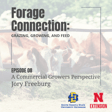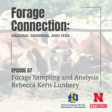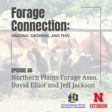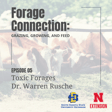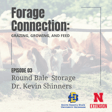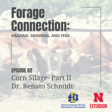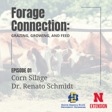Become a Creator today!Start creating today - Share your story with the world!
Start for free
00:00:00
00:00:01

Grazing Corn Residue: Dr. Mary Drewnoski
We talk with Dr. Mary Drewnoski, beef systems specialist from the University of Nebraska - Lincoln about utilizing crop residues as a forage resource; what options do we have, what quality can we expect and how do they fit into our production systems. We also get an update on some new research in the field.
Transcript
Introduction to The Forage Connection Podcast
00:00:04
Speaker
It's the Forage Connection, grazing, growing and feed with your hosts, Ben and Sarah.
Guest Introduction: Dr. Mary Janowski
00:00:10
Speaker
Today, we're going to talk about using crop residues. Joining us is
Exploring Cover Crops and Forages
00:00:14
Speaker
Dr. Mary Janowski, a Beef Systems Specialist with the University of Nebraska, Lincoln. Mary, we're happy to have you here with us today. Beef Systems Specialist is a pretty broad title. Could you share with us a little bit more about your background and what you do at the university? Well, I am a ruminant nutritionist by training and I pretend to be an agronomist on other days.
00:00:34
Speaker
But I work in cropland forage resources. So cover crops, annual forages, and of course, crop residues. So that's
Focus on Crop Residue Utilization
00:00:43
Speaker
what we're going to talk about today is crop residues and how to use them as a feed resource. That's kind of been your, at least one of your focuses since you started this role at the University of Nebraska. If I remember correctly, Mary, weren't you hired as kind of part of a
00:01:01
Speaker
a cluster hire to really focus on crop residue utilization? Yeah, cluster hire is a great word. But yes, I was hired with actually with a forage agronomist, Darren Redfern and an economist, Jay Parsons. And we work together basically on cropland forage production. And so as I was talking about, like corn residue is probably at the heart of what we do. I'm not sure I've
Benefits and Challenges of Corn Residue
00:01:28
Speaker
ever had a year.
00:01:29
Speaker
in the decade that I've been here where we don't do something looking at grazing corn residue and how to increase our optimization of it, if that makes sense. Sure. So you've been looking around the situation in this issue for quite a while. So we're excited to chat with you a little bit about it today. Yeah, it's not exactly a new topic now, is it? There's always something new to learn. Well, Mary,
00:01:58
Speaker
There's a lot of crop residue options, right, Mary? In the Upper Midwest, we commonly see people grazing corn stocks in the wintertime, but that's not the only crop residue out there. What residues do you typically work with and where do you see some of this research heading and management practices heading as far as winter grazing opportunities and usefulness of residues and their quality?
00:02:23
Speaker
Well, so I mean, to be frank, corn residue is king. I mean, of the residues, corn residue is the one that's probably the most prevalent. The probably second best in my mind, and it's not necessarily from a quality perspective, because actually sorghum residue is quite good. It's just usually more limited in terms of how much is out there, in terms of biomass, as well as just acres, right?
00:02:51
Speaker
But if I was to pick one that's pretty doggone good, it would be milo residue. And then the other one that, you know, often people try to use is soybean residue. And I'm not a fan. I always tell people soybean residue is basically like sawdust. If you look at the feed value, it's not very good. Yes, there's some pods out there that they can pick, but they cannot eat enough.
00:03:17
Speaker
to meet their needs. So if you, you know, a lot of people, they say, well, if I fence in, you know, my field and I have corn residue and I have soybeans, I see them over there on the soybeans. Yeah, they're going and eating some of those pods, but they cannot eat enough in a day to meet their needs, even if there was enough pods out there, if that makes sense. So it's not a really great resource. And then baling it, it is sawdust makes some bedding, but you don't have a lot of cover anyway. So
00:03:48
Speaker
I'm kind of anti soybean residue just to be frank, I want to leave it on the field. That's understandable. You know, great erosion control and soybeans don't leave a whole lot of residue there in the first place. So leaving something is certainly better than leaving nothing when we're talking about keeping our soils covered over the winter from an agronomic standpoint. But you mentioned that corn is king and sorghum is maybe a close second.
00:04:13
Speaker
So let's talk a little bit about corn, the quality of corn residue, the usefulness of it, and maybe if someone doesn't do a whole lot of winter grazing, what might be the draw to start or to try? Well, the first thing is corn residue is, in Nebraska, corn residue really helps us to have as many cows as we have because corn residue is cheap.
00:04:42
Speaker
And so I think it's really important to recognize in terms of its value, it's actually typically undervalued relative to other feed opportunities, right? When you compare it to hay, grazing corn residue is typically a lot lower cost. Now, the other thing you got to recognize about corn residue is that cattle are selective grazers and husk and leaf are the things that they want to eat.
00:05:10
Speaker
So the other benefit to grazing is that you can go out there, take the best of the residue and leave the rest for cover. Whereas when you're bailing it, you're hauling everything off. And even if you are somewhat selective, let's say you don't put the rake down to scrape the ground and you try to be conservative, you're still
00:05:37
Speaker
not selecting all the best, you still are taking stocks, then you're hauling it, and then you gotta haul it back as manure. So I mean, it's just efficient to be grazing and allow those cattle to be selective. So husk, I think people underestimate it. Husk is the, if I was to think about the key component in corn residue is husk. If I evaluate a field, that's the thing I'm looking for. How much husk is out there?
00:06:06
Speaker
And we tell people our typical rule of thumb with grazing corn residue is you have one AUM, so one thousand pound cow for a month for every hundred bushels of corn that was harvested because the amount of residue is correlated to the amount of corn grain that's produced.
Impact of Grazing on Crop Yields and Soil
00:06:27
Speaker
However, one of the challenges with corn residue is that it's not attached to the ground anymore.
00:06:35
Speaker
which means wind is your enemy. And depending on how high you chop the stocks and which direction the rows are going and all of those things, husks sometimes disappears. I don't know anybody driving down the interstates probably seeing on the road ditch, you know, tons and tons of husk. If it's not in the field to graze, it's no longer a good feed, right? So when I go out, that is what I look at as a way of kind of monitoring, saying,
00:07:05
Speaker
Okay, is it time to go? If I'm not seeing a lot of husk, it is time to go. It doesn't matter how much other residue is out there. So when we're thinking about that from a quality standpoint, and we know that the quality of that residue is going to decrease over time just because it's starting to decompose somewhat. But even if we have, you know, a pretty good fall and winter conditions, and we don't get a lot of decomposition,
00:07:32
Speaker
If that husk's getting blown off the field, we're really losing quality pretty quickly then. Yeah. In fact, I think the data actually suggests decomposition is not a major contributor to loss, but wind is. Especially because we lose husk. Husk is quite high in TDN, like 70 to almost 80 TDN, depending on the variety of corn.
00:08:03
Speaker
It's the best stuff. And when that leaves, then indeed, you'll see a decline in the feed value that's out there. And most of the studies that have actually looked at if they have, where they don't have wind loss, they don't really see a lot. But when they actually allow for wind loss, then they actually do see a decline over the season.
00:08:28
Speaker
So that wind that keeps us from all falling over in the plains here is really damaging our crop field quality as it blows in the fall. Yeah, so your most protected fields are the ones you should wait to use. So the ones that have the most trees in your fence line, because they're probably going to have the most husk that hangs around, if that makes sense.
00:08:55
Speaker
Well, and from a harvest standpoint, Mary, I don't know if you've measured it, probably be more on the cropping system side than the feed side, but leaving a little more stock out there to protect the residue that's laying on the ground. And depending on how much you chop that residue as it comes off the back of the combine, right? That probably makes a difference too. Yeah. So to the first part of your question, which was about how high the chop
00:09:24
Speaker
I do think that is a big contributor, and I haven't seen any data, but if you just look at what you would expect in terms of wind speed and erosion, which I would think is a pretty good indicator what you're going to see for huts taking off, I think it just makes sense. The higher the chop, it's kind of better. But I do think a direction of the rows also makes a difference because
00:09:51
Speaker
can get that wind going in between like down a row so depending on what the direction of your wind is that can also have an impact. Now your second part which was about chopping is a question I have gotten for like the last five years and I finally got funding. We are doing a project this winter where we're comparing chopped to not chopped because the theory
00:10:18
Speaker
Here's my hypothesis. My hypothesis is that chopping it eliminates some of the selectivity that cattle can do. It may increase standardization, but definitely I think you're going to see that the quality of what they consume is going to be less and thus the animal performance is going to be less. So we're going to evaluate that and see like how much difference it makes
00:10:45
Speaker
If it's mostly degradation is an issue, then if you are renting fields, which a lot of people aren't in charge of the agronomic side, they're just renting fields, then maybe you're deciding, I'm going to go into those fields first, those animals early in the, your cows typically early in the winter, they have a lower requirement and it increases as they get later into gestation.
00:11:08
Speaker
Plus, then you wouldn't have as much derivation law. So maybe you're picking fields that are chopped and they are going in those first and the ones that aren't you're going in later. That's some of the questions we have. I don't know the answer. That's just what we think at the moment, but I'll let you know next year. That's going to be really interesting.
00:11:28
Speaker
So we need to have you back on then is what you're saying, Mary. Yeah, I'll give you an update. We can do a real short one. All right, what did we learn? Yeah, we want to know. We want to know. Well, I think if you talk to the people in the world of soil health, we're always hearing about distributing that residue evenly. That's a big thing in no-till fields, especially as you go back in. But if you're grazing it, it's maybe not as serious because those animals are going to clean that up. So that'll be really interesting to hear from.
00:11:56
Speaker
Yeah, your comment there. So one of the fields that we've done a lot of research on is a high yielding irrigated field. And I don't know. I think in that field, we've had treatments where they've been grazed or not grazed for over 30 years now. So yeah, pretty cool. Of course, that started way before me, just to be clear, people. I'm not that old.
00:12:27
Speaker
That field is really cool. When I got here 10 years ago, I actually summarized the first 20 years of data. And what we saw is that in those high yielding fields, grazing actually increased the subsequent corn and soybean yield over top of the not graze. And I think part of it is, I mean, you just have so much residue, right? So taking some of that off is helpful. Plus, we saw an increase in microbial biomass. So I think we had nutrient cycling
00:12:55
Speaker
that was sped up a bit and allowed maybe a little bit more nitrogen being available for the soybeans. The soybeans had, I mean, it's small. It's like two to three bushel increase. And corn, it was less than five bushels. But to me, it was real positive that it was positive. And it was even positive, like there was actually three treatments
00:13:20
Speaker
there was fall grazing, there was spring grazing, which was like worst case scenario people. We tried to do it when the ground was thawed and they actually had like one and a half times the stocking rate. So they were trying to kind of make it fail. But even that one showed a positive response. It wasn't quite as positive as the fall, but it was still positive. And a couple of years ago, we took it to the extreme and we did in the
Nutritional Needs of Cattle Classes
00:13:47
Speaker
spring grazing,
00:13:48
Speaker
we triple stocked it and we waited until it rained and so we didn't put them out until like mid-february and we just we put them out for a short period and put a whole bunch out there and they i mean they trampled it in it it looked like we had plowed to be frank it was no till filled but it it looked bad um we got even greater yield increase in that that particular treatment it
00:14:16
Speaker
To be clear, what everybody's probably thinking is, oh my God, who wants to plant that field, right? There is a lot of surface roughness and we did have to slow down the plant. But what I'm not telling people to go out and do this in the spring. What I'm really telling you is if you have a moment, you make a mistake, you know, you're out in the field, it's stalled and you do get the pugging. It's not going to be the end of the world.
00:14:45
Speaker
It's a very short-term kind of thing. We'll see a slight increase in penetration resistance, which is what you'll feel when you're planter, because you'll have to change your planter setting. You'll have to put a little more down for it. It goes away very quickly, like we can't measure it anymore, like by June. So not advocating for the mismanagement, but just saying it's okay. You really can't do a lot of damage, unlike what you might think.
00:15:14
Speaker
Well, there's something to be said about that natural systems approach, right? We want people to avoid overgrazing and we definitely don't want those ruts in those no-till fields or in any field with that compaction, but that natural hoof action and grazing system just seems to recover a whole lot faster than other forms of compaction and issues that happen in our... It's key to understand it's all surface and that is what's so helpful about it because it's really in the top two inches.
00:15:42
Speaker
And so you have more of the wet dry cycles, you have more organic matter, and you have more microbial biomass. So you just have a lot going on for you to ameliorate that effect. It's not like when you think about wheel traffic that gets deep and you don't have as much activity on those deeper levels. That's why I pretend to be an agronomist. No, you're doing a great job.
00:16:08
Speaker
So that's kind of a, I'd say a long-standing criticism of grazing crop residues, Mary, is that fear of compaction and what it's going to do on subsequent yields. So it's really great to hear what you've been able to uncover in that area. I've got a theory on this and maybe, Sarah, you've got some thoughts. I wonder if
00:16:30
Speaker
There isn't some difference in what we've been able to do with our planters over the years that when we had older style planters, that seed placement probably was impacted a lot more by some of that surface level compaction. And as we've really stepped up our game from a planting standpoint,
00:16:51
Speaker
some of that roughness on the surface level doesn't impact us quite as much. But we're holding on to that, that old perception of what it's done in the past. I'm not an agronomist either. So I should clarify my comments. But no, there's some truth to that. And some of it is just management and planter settings. You know, like you said, we have
00:17:13
Speaker
updated equipment and it's a little easier to set down pressure on a lot of this equipment now with airbags and there's different options with different planters. But I think people also as we pick up more and more no-till acres and more people interested in grazing those acres are noticing ways to manage it. And then when you do have issues like Mary mentioned, say it's 2019 and you're desperate and you've got to turn those cows out and it starts to thaw and it gets rough out there.
00:17:43
Speaker
There's definitely things we can do with our planter to mitigate the issue. You might have to slow down. Really understanding the difference between depth and down pressure, I think is a big one. And if people really want to dive into this, Paul Yasza with UNL, Dr. Yasza has all kinds of information on this very specific topic. He would love to talk. Maple will have to have him on sometime. He would love to talk to you about it. But that's true, Ben. There is definitely some truth to that.
00:18:12
Speaker
And some of it is, like I said, just settings and management. Some of that technology has been around. We just are getting better at it, I think, better at learning how to make things work. I've also heard soybeans are pretty good at filling in. So we did emergence data. And I feel like on the high stocked one, we did see a little bit less emergence.
00:18:43
Speaker
and then we got higher yield. And it was like, how, right? But I think there is some data that says you can get some nitrogen response in soybeans. So I really think the nutrient cycling part of it is part of what's going on there. Sure. So circling around maybe way back in the conversation, you mentioned, Mary, that typically we see
00:19:11
Speaker
open cows, spring cabin cows out on our residue fields. And we've been talking about especially the corn residue from an energy standpoint. When we're thinking about stocking these and utilizing these fields, does it matter what class of livestock that we're using? You know, we're talking about it as a great energy resource, proteins, the other side of that equation when we're talking about livestock diets, how does that fit into this whole situation and system as well?
00:19:41
Speaker
Yeah, so dry cows are probably the optimal just because in terms of requirements, even though the protein content is actually quite low on corn residue, like the corn itself, any down corn or a grain that got missed is the highest protein content out there at like eight to nine. Husk is like three. And actually, that's part of why I think they eat leaf, although that sounds funny, but leaf is usually
00:20:08
Speaker
you know, five, six, something like that. So in theory, even a dry cow should be protein deficient. However, I would say the cattle never lie, right? And what the cows tell us is they're not. We do not see a benefit to protein supplementation of dry cows if we stock appropriately. And the reason, the key difference is that the
00:20:39
Speaker
content of the corn residue being higher digestibility, it's not like dormant range where it's low digestibility. So you know the protein response you see in dormant range, you actually see an increase in intake.
00:20:52
Speaker
because you gave them some protein and you increased basically the microbial activity and thus you're actually getting more into them and so you're getting a positive effect. That's not just supplementing protein to the animal itself, it's about supplementing the microbes. In this case, because it is a higher digestibility feed, we already get a pretty good intake rate. And then the other thing to understand about it is that cattle
00:21:20
Speaker
are really great at nitrogen recycling. And so as you feed them less nitrogen, they actually change the excretion of nitrogen. So they don't put it in, the kidneys don't put it into the urine and it pumps it back into the blood and then it can come back to the saliva and back to the rumen and be a source of nitrogen for those microbes to keep them going.
00:21:45
Speaker
So I think what we see is actually our nutrition models, they completely ignore recycling. We just don't have the ability to predict it because it does change based off of the amount of protein that's in the diet. So we probably underestimate and that's why we get away with it. But the animal performance tells us we're okay
00:22:11
Speaker
as long as there's enough husk and leaf out there for them to select. As we get into later in the grazing season, when cattle are out on residue, right, they start selecting leaf and husk and eventually, if you leave them on too long, they're filling in. And in fact, they fill in with cob and upper stock. That's where you run into a problem. So, to be clear, I'm talking about dry cows. Now, let's move on to other animals, right?
00:22:39
Speaker
So everybody else has a higher requirement. So you're going to guess that I'm going to tell you we do need to supplement. And young cows, like two-year-olds, you need to supplement them. And they actually need both protein and energy. And in my head, I have three pounds of protein is what they actually need. So it's not an insignificant amount. Maybe it's three pounds of distillers. It's a third of a pound of protein. I should get that right. I should have looked it up before I got on here.
00:23:08
Speaker
But young cows are different. So my suggestion to most people, if you got thin cows, because this is the other thing, thin cows have a higher energy requirement in the winter. Not just a game, which is probably what you need them to do, but just to maintain. Because in cold weather, they don't have the insulation factor. So they have a higher requirement. So thin cows and young cows, I'd put them together, and then I would supplement them.
00:23:34
Speaker
Then we have heifers. So if you're trying to develop heifers, you can do that on stocks very cost-effectively, but you've got to supplement both protein and energy. But here's the kicker. With heifers or even growing calves like stalkers, you can do that very cost-effectively. But they need not just protein and energy, but they actually need bypass protein. They need true protein that gets to the animal. You can't feed enough energy
00:24:04
Speaker
and roomly available protein like urea to actually get good gains. So what you need to do is actually feed a bypass protein. And we're in Nebraska, so I'm gonna tell you distillers is like, I mean, it's really hard to beat it. There's a reason why we talk about it so much. And it is because it's kind of magical in that it has that bypass protein. So we did a study, oh gosh, years ago, probably like five years ago,
00:24:32
Speaker
where we actually had the same amount of protein energy coming from corn and urea as we did from distillers. And so we were equal pounds of protein, pounds of energy that we were supplementing. So we were actually supplementing more corn and urea than we were distillers. And the performance response is threefold on the distillers. So we're feeding less of it and getting three times more performance or gain out of those calves.
00:25:00
Speaker
So it is because it's a bypass protein source. And if you don't feed them anything, they lose weight. So we had a control and they did, they lost about a tenth of a pound a day. So to be clear, you do need to supplement young cows, thin cows. You need to supplement growing animals, so your heifers, your growing calves. And then we have lactating cows. Okay, fall calving cows is the other question.
00:25:30
Speaker
And they need both protein and energy, and it's not an insignificant amount of energy. And it's really hard to get enough into them without feeding them some type of concentrate like distillers. Like if you look at just feeding alfalfa, the amount of alfalfa and corn that you have to feed flabbergasted most people, they think I'm crazy.
00:25:52
Speaker
and if you start looking that's again it's so magical how little distillers you have to feed to actually get what you need into them. So if people are interested in that I'd tell you if you google it we have quite a few articles actually kind of outlines for growing calves how much distillers do you need to feed to hit certain rates again and then for lactating cows
00:26:17
Speaker
what do you need to feed to actually meet their needs? It is usually something that most people don't understand because when cows are out on pasture, it seems like, man, they get along just fine. But they have a lot of energy and protein requirement during that lactation, especially peak lactation when you're trying to breed them. You can get yourself in a world hurt trying to use a protein block.
00:26:45
Speaker
So Mary, for folks that might be listening to this and maybe don't have distillers readily available, are there any other, I know maybe not exactly comparable, but other options that they should be considering that would get close to just the efficiency that you get in a corn distillers byproduct? I don't know about close to the efficiency, but another good source of bypass protein would be cotton seed meal.
00:27:12
Speaker
which is another thing that some people can get that when they're not be able to get the stillers. Blood meal is another one. It's not palatable, but if you're making a pellet, you could put blood meal in there. And then there's another, there's a protein source, it's called soy pass. And it's basically, it's basically heated soybean meal, to be frank, but it's also got bypass protein.
00:27:39
Speaker
So that's another option that you could mix in with some grain and actually meet the needs. Usually though, when people say I can't get distillers, it's not as cheap as like it is in Nebraska. But often when you look at the cost,
00:27:56
Speaker
even getting dry distillers for a higher cost often still is a lower cost option than trying to make do without as much bypass protein because of how little you have to feed. So don't just look at the price. You actually need to budget according to how much do I have to feed to meet the need compared to how much do I have to feed of these other feeds to meet the need. It's not a one to one thing. It's not just looking at price per ton guys.
00:28:25
Speaker
I think that's really interesting, Mary, because there's a lot of producers out there just from contacts and driving around and looking that are supplementing with alfalfa. And they probably have alfalfa source or they raise it themselves, then it's easy. And they are used to doing that. But looking at supplementing with distiller sounds like it could be a much better and cost-effective option. So something to look into.
00:28:52
Speaker
And to be fair, a lot of people are supplementing with alfalfa. It's usually dry cows. Yeah. A lot of folks with dry cows, but full calving is not uncommon, you know, in this part of the world. And, um, I think there's also a lot of people with mixed herds that have young, young cattle in there that might need some supplementation, like you mentioned. Yep. I think it's always worth, um, checking into and, and for anybody at say,
00:29:16
Speaker
Use your extension people. They can help you do the math. Tell them what you got, what the costs are for what you can get, and let them help you figure it out. Because there's always a lot of options. And what fits for one location doesn't fit for another. So for me, it's kind of fun to do little puzzles and figure out what's going to work. Something that I've been getting some questions on here, Mary, and this is probably going off in a totally different direction.
00:29:46
Speaker
with some of the dry weather that we've had this year. And we know that we fertilize, especially cornfields, fairly heavily just to make sure that we're getting that optimal yield potential covered. Is there any risk when we're looking at grazing crop residues that might have had a little bit of drought stress from a nitrate poisoning standpoint? Because we talk about nitrates from a lot of our annual forages,
00:30:15
Speaker
Corn is a annual crop again. And so it kind of makes that association. Yeah, it does accumulate nitrates. But here's the thing. If it's a whole field, I don't worry nearly as much. And here's why. Because I told you, what are we concentrating on them eating? Here's your test, Ben. What do we want them to eat? We want them to eat husk. Husk and leaf, right?
00:30:44
Speaker
Okay, great thing about huskin leaf is that's not where the nitrates are. So the nitrates are going to be in the stock and in particular the lower stock. So if it's a whole field, the cattle are going to eat huskin leaf first. The only time, so I don't worry about it honestly. I do not get antsy if I have a whole field that's drought stressed as long as I don't over stock it and over graze it.
00:31:10
Speaker
Where I get antsy is when you have an irrigated field and you have dryling corners. And the reason is because those dryling corners are higher quality, meaning there's less maturity, less lignin in there, and the cattle will have a preference for them. And so if you fence in the dryling corners, they will go and devastate them, right? They will eat the leaf, the husk, the stem, and they will eat it down.
00:31:39
Speaker
And that's where you can run into a potential problem.
Managing Nitrates and Drought Conditions
00:31:43
Speaker
So my suggestion to people is if you have that situation, so one time I'd say don't fence in the dry lane corners. If you have enough dry lane corners stuck together, right, it's like you got the four together, we'll fence them separate and use them, but again, use them lightly. So that's my suggestions on the nitrate thing. The other thing that you can do, if you are really concerned about it,
00:32:09
Speaker
is grain is your friend. It's your best friend when it comes to nitrates because nitrates have to be converted to nitrite in the rumen and that's the toxic compound and we have the microbes in there that already do that. They're always present but we have some other friends who can take nitrite and convert it to ammonia and use it to grow and multiply. If you feed them energy
00:32:37
Speaker
they will grow and multiply more quickly because they're using the nitrite as a form of protein. So we see a reduced risk of nitrate poisoning on higher energy diets. And in particular, there was a really cool study out of Oklahoma where they actually looked at feeding cows grain. And so they just fed them corn grain at various levels and they showed dramatic reductions in the amount of methemoglobin that was in those cows. And so like three pounds of corn
00:33:07
Speaker
is magical. So just, so if you are kind of pushing it a little bit or you're a little bit, you know, I'm not suggesting doing it, but if you're in a situation where you're a little worried, feed them some grain, that'll lower risk. Also, adaptations really, really valuable. So the one nice thing about them, they graze, you know, the usually the parts that are actually the lowest nitrate first, so they kind of work their way into it anyways.
00:33:35
Speaker
They like the ice cream first, don't we all? Yep.
Current Studies and Future Research
00:33:39
Speaker
I don't want to eat broccoli. Right? Mary, we've covered a lot of topics here, but really, I think you shared some great insightful points on grazing corn residues in specific with different classes of cattle.
00:33:53
Speaker
And I think we could talk about this all day. I know you've done a lot of research. We were discussing that today before we were recording. Is there any closing thoughts you have on emerging research or things you're working on that you'd like people to hear about? Well, I told you about the chopping study. I'll tell you about one more that hopefully I'll have some better answers on in the future as well.
00:34:16
Speaker
we started looking at, our producers were telling us they get variable responses when cows are out on corn residue. And so we were trying to figure out why. And one of the things that we went and looked into was actually, how does the quality of the residue change with grain yield? And so as the grain yield increased, we learned that actually the energy content of the husk and the leaf declines. So higher yielding fields have lower quality residue.
00:34:46
Speaker
basically, the residue that they're going to be selecting. And it's not insignificant. So if we look at it as I told you at the beginning, one AUM for every 100 bushels. Well, when I start looking at the TDN yield per bushel of corn grain, lower yielding fields like 100 bushel an acre fields have like 10 pounds of TDN per bushel of leaf and husk.
00:35:12
Speaker
And if we go to higher yielding, like 250, it goes down to 5. So the question now is, does that mean we should actually be stocking the 100 bushel and the 200 bushel at the same amount? 1 AUM per acre now instead of 1 AUM per 100 bushels and have twice as much
00:35:37
Speaker
stocking rate on the higher yielding field. I don't know the answer because there's some challenges. One of the challenges is how animals perform is a combination of intake and quality. And so the question is, in these higher yielding fields where there's more availability,
00:35:59
Speaker
can they actually make up for an intake? And I don't know the answer to that. So again, the cattle are the only way to know. So we've got to do a study where we actually compare it before I can tell you for sure that's what you should do. But maybe in another year or two, I'll know the answer. That's going to be an interesting one for sure. And you've got the whole hybrid selection factor too. You know, if it's a grain,
00:36:25
Speaker
for our forage type or a dual purpose hybrid, you know, you might see different things too. So that sounds like some really interesting research. Yeah, my assumption is nobody, everybody's going to plant corn for the grain and then we're using the residue as a byproduct. And so it's really about how do you deal with what you got and how do you know what you have? Yep, definitely.
00:36:48
Speaker
Well, I think you've secured a spot on our podcast in the future here, Mary, to have a follow up on some of these. That's what I was angling for. Yeah, I think we had a really great discussion about all things there with crop residues. Is there any, I guess, final words, anything that we've left out or need to cover yet? I say stay tuned. We'll see what else we learn. I got another 20 years in me yet.
00:37:18
Speaker
Well, we appreciate it very much for taking the time to chat with us today, Mary. And we thank all of you for joining us for The Forage Connection.
